With this two-part exhibition from the Paris-based artist Clément Cogitore (b. 1983, Colmar) the Kunsthaus Baselland presents the first solo exhibition in Switzerland by the 2018 Prix Marcel Duchamp winner. In a practice that has developed over many years, the French film-maker and photographer deals in-depth with the question of how pictures from advertising, entertainment, social networks or even rituals, secrets and illusory worlds all work, these pictures which occupy an active role in the creation of ways of life. With a variety of works the first exhibition sequence will offer an overview of his work in recent years, while in a second part from mid-May his new work The Evil Eye, with which he won the 2018 Prix Marcel Duchamp, will, for the first time, be the focus of an institutional presentation.
Telling stories, or just listening to them, is a wonderful thing — the real can mix with the fantastic, everything seems possible, the course can change anytime, fantasy becomes activated. The film maker Clément Cogitore is just one of those storytellers, even when it‘s not about exactly about fiction. He rather extrapolates the poetic, the unique, at times the irritating from everyday moments and reality — not only in his films, which can be short or feature length, but also in his photography series. In his ever growing body of work, the French film maker and photographer extensively debates the question of the role of imagery in advertisement, entertainment and social networks, but also rituals and illusory worlds, taking on an active role in the construction of life scripts.
A prime example of his artistic method is his renowned film Les Indes galantes, for which he gathered krump dancers, a kind of hip hop dancer, from in and around Paris for a one-time enactment of the 3rd act of Jean Philippe Rameau‘s 1735 ballet opera Les Indes galantes(The amorous Indies) inside the opera house in Paris. But it‘s not only the 18th century piece that is compellingly brought to the present through these young people and their powerful, maverick dance. Nor is it just the act of giving a stage to someone who otherwise eludes publicity — like these dancers. Clément Cogitore is just as much interested in the events beforehand and behind the limelight, what kind of aftermath a piece can have for those involved. These moments can occur especially when two worlds and seemingly separate areas converge. Just like this form of youth culture of krump dancers, which emerged from the outrage of 1980s Los Angeles‘ ghettos, now coming upon the prestigious Opéra National de Paris with its traditions and rituals. It‘s exactly these points of contact that Clément Contigore pursues in his work time and again: the uncontrollable, energetic, but also the mysterious, at times manipulative and not always rationally explainable that we encounter over and over, yet we aren‘t always ready to see, to examine, to experience with all our senses. On occasion of the exhibition at Kunsthaus Baselland, Ines Goldbach met Clément Cogitore for a dialogue.












